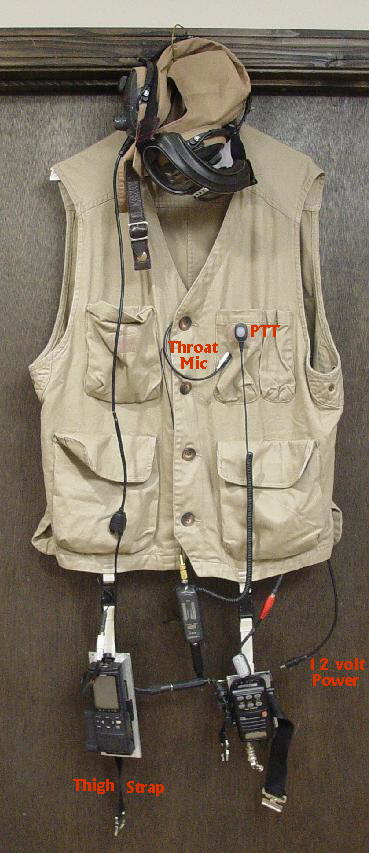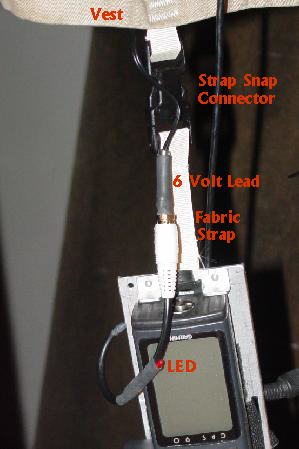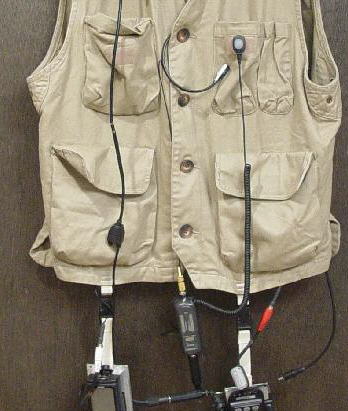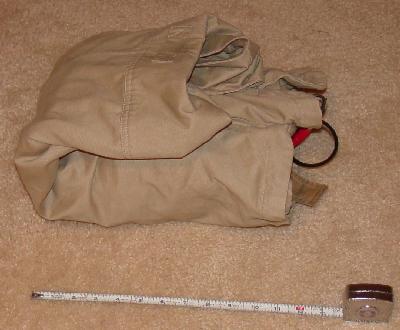|
|
 One of the problems of flying an ultralight vehicle is how do you add safety equipment with out adding to the vehicle weight? Taxiing around and through other aircraft on hard surfaces means that one has to add the weight of brakes. But in the case of a radio and gps for pattern communications and shortest path to an airport location, the weight can be added to the pilot. To the left is my latest solution. It weighs a little over seven pounds which includes the helmet and goggles.
One of the problems of flying an ultralight vehicle is how do you add safety equipment with out adding to the vehicle weight? Taxiing around and through other aircraft on hard surfaces means that one has to add the weight of brakes. But in the case of a radio and gps for pattern communications and shortest path to an airport location, the weight can be added to the pilot. To the left is my latest solution. It weighs a little over seven pounds which includes the helmet and goggles.
This system has evolved over time. At first I started with a goggles, soft flying helmet, and headset to keep the wind and debris out of my eyes and Rotax 447 and propeller noise out of my ears. Then I added a radio strapped around my left thigh so I could listen to other pilot communications through the headset. Next I strapped a gps on my right thigh so I could fly the shortest route to and from K02 for EAA Chapter 453 meetings. I discovered the batteries ran out of juice at inopportune times. I added twelve volt dc adapters to the seat cheek board sides so that the radio and gps could be continuously operated. And finally, I adapted a throat microphone so others could receive my radio transmissions free from wind, engine, and propeller noise. As it was, the system worked well, but it was cumbersome to use. To prepare for flight, I would place the radio and gps on the floor boards before getting into the FireFly. After getting in, I would strap one to each thigh and connect a power cord to each side of the seat. Then I plugged in the radio microphone, headset and antenna and belted myself in. |
 Two years ago, my wife gave me a vest for Christmas, and I saw a chance to organize the whole works and to remove some weight from the FireFly. The gps and radio were suspended from the front vest bottom by using strapping material and plastic quick strap disconnects. Slots were cut in the top edge of the aluminum backing boards to pass the strap through.
Two years ago, my wife gave me a vest for Christmas, and I saw a chance to organize the whole works and to remove some weight from the FireFly. The gps and radio were suspended from the front vest bottom by using strapping material and plastic quick strap disconnects. Slots were cut in the top edge of the aluminum backing boards to pass the strap through.
A power cord comes down behind the strap from the vest. An RCA phono female socket was used on the power cord to prevent accidental shorting of the center connector to ground. The male connector was used on the gps and radio side because both are reverse polarity protected. They cannot feed battery current back out through the center connector. A light emitting diode (led) was placed into gps and radio side of the power lead as a power on indicator. When I put on the vest all one has to do is to connect the cross straps around the thighs and you are ready to get in the FireFly. |
 The twelve volt power converters and power fuse have been placed in a pocket just behind the left side lower front vest pocket. The radio power lead comes straight down from this pocket. The gps power lead is fed around through lower vest hem to the right side. The black male phono plug dangling on the vest left side near the radio plugs into the mini control panel twelve volt power socket.
The twelve volt power converters and power fuse have been placed in a pocket just behind the left side lower front vest pocket. The radio power lead comes straight down from this pocket. The gps power lead is fed around through lower vest hem to the right side. The black male phono plug dangling on the vest left side near the radio plugs into the mini control panel twelve volt power socket.
I still have some what of a mess with the microphone, PTT switch and headphone leads. I believe this can be corrected by bringing down another lead from the upper left breast pocket to the radio to connect the microphone and headset. The PPT switch is not a problem because it has a extendable cord. I would then shorten the headset and microphone leads so that I could plug them in up high. This would let me connect these units after I had put on and zipped up outer protective clothing. But without these changes, it is much easier than before. I can walk out get in, plug in the power, connect the antenna, stick the PTT switch to the control stick, belt in and I am ready to fire up the engine. Also the reverse makes it much easier and quicker to get out of the FireFly. |
 To keep everything organized, I take the vest off and lay it down on its back. I fold the radio and gps up onto the inside back surface. To protect the goggles, I place my neck sock over them and place it with the radio and gps. The microphone is placed in a breast pocket. Then I fold the vest sides over tight and the top down to the bottom. It makes a very neat package that can be placed into a soft carrying case.
To keep everything organized, I take the vest off and lay it down on its back. I fold the radio and gps up onto the inside back surface. To protect the goggles, I place my neck sock over them and place it with the radio and gps. The microphone is placed in a breast pocket. Then I fold the vest sides over tight and the top down to the bottom. It makes a very neat package that can be placed into a soft carrying case.
|